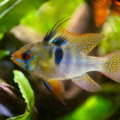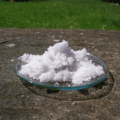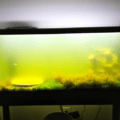Umbrella Cichlids are small with bright multicolored scales that leave a striking impression. This article will provide health tips on maintaining these beauties in a community tank.

This Apistogramma Borellii care overview is for aquarium owners who want to build their tanks with small yet colorful and striking species. It’s easy for small fish to get lost in large community tanks, but not this variant, and you’re about to discover why.
Umbrella Cichlids have multicolored scales that stand out in any tank. Because of their sensitive features, these beauties are prone to illnesses and harm. But don’t worry, I’ll arm you with enough dwarf cichlid care tips to ensure long life and good health for your pets.
See Also: 10 Types of Colorful African Cichlids
The Stunning Colors and Traits of Apistogramma Borellii
Before we get to the care guide part, let’s start with Umbrella Cichlid identification tips.
Color Pattern

Apistogramma borellii’s appearance is popular for having multicolored scales on such a small body. It grows about 2-4 inches (6-8cm) long and has a lateral body covered in metallic silver scales with golden-yellow fins. That’s why it’s sometimes called the yellow Dwarf Cichlid.
Meanwhile, the Umbrella Cichlids head has spotted yellow, red, and blue scales around its black eyes.

Unique Traits
As you can expect, this species has typical colorful freshwater fish traits like being territorial during breeding, wanting to show off its beauty, and enjoying schooling. You can also keep your Umbrella Cichlid school within a multi species community tank.
Whichever you decide, here’s how to create the perfect home for your pet.
Crafting the Perfect Home for Apistogramma Borellii
When crafting an Apistogramma Borellii’s tank setup, your primary focus should be on its natural habitat, the Paraguay River Basin of South America.
What does that look like? You may ask. I’ll help you visualize it.
Tank Size and Layout
Because Umbrella Cichlids are small, your natural aquarium habitat should hold about 20 gallons of water per trio. I recommend using a rectangular tank instead of a tall one to accommodate its long body.
Water Parameters
Once you’ve picked your tank, it’s time to fill it with water, but not just any water. Use a test kit to ensure the following parameters for ideal living conditions:
| Temperature | 72 – 82℉ |
| pH level | Slightly Acidic at 5.5 – 7 |
| Hardiness | 1 – 10 dGH |
| Filtration | Gentle (Sponge or Adjustable Canisters) |
| Water Changes | 25 – 30% Weekly |
Decor and Substrate
Hold on; that’s not all!
Dwarf Cichlid tank requirements don’t stop at water parameters and tank size. You must also ensure the decor and substrate are compatible with your pet’s features.
| Substrate | Decor |
| Soft – Sand, Fine Gravel, or Small Pebbles. | Plants – Java Fern and Floating Moss or Artificial plants. Hiding Spots – Caves formed with Driftwood or Tall Plants. Lighting – Dim and regulated for day to night. |
Feeding Apistogramma Borellii for Vibrancy and Health

You can use a regular dwarf cichlid diet guide for your Umbrella Cichlid because they’re also omnivores. But if you’ve never seen one, here’s what an umbrella Cichlid nutrition looks like.
Diet Suggestions
- Staples – High-quality commercial pellets and granules.
- Supplements – Live, Frozen, or Freeze-dried food like Brine shrimp and Bloodworms.
- Vegetables – Blanched spinach or zucchini
For more on feeding your aquatic pets check out The Ultimate Guide to Fish Food: Pros and Cons & Best Choices!
Feeding Tips
When feeding Apistogramma borellii, maintain a strict regimen. Feed them portions they can finish within 2-3 minutes once or twice daily; it’ll prevent food-related illnesses like bloating and water pollution.
I’ll expand on that soon, but first, let’s talk about adding new Umbrella Cichlids to your tank through breeding.
The Joy of Breeding Apistogramma Borellii in Your Tank
I’ve split the breeding process into two to make it easy for beginners to understand. The first part is the setup, while the second focuses on post-spawning care.
Breeding Setup
Change the tank environment setup when breeding Apistogramma borellii to encourage healthy reproduction. Here’s how to do that –
| Breeders | 1 male to 2 females |
| Temperature | 70 – 72℉ |
| Filtration | Peat |
| Hardiness | 1 – 3 dGH (Soft) |
| Decor | Indian Almond Leaves for Tanin and flat surfaces for the eggs |
After spawning Dwarf Cichlids’ eggs, the males fertilize and guard them until they hatch within 2-3 days.
Fry Care Tips
Typically, Umbrella Cichlid fry, like other fish fry, feeds on their yolk sac in the first few days of their life. Then, they survive on infusoria and liquid fry food. After about 4-5 days, they grow larger and become free-swimming. At this stage, they’ll forage for food in the substrate, so you can add baby brine shrimps to their diet. As they get larger, prepare them for the main tank.
Remember that raising Umbrella Cichlid fry is a sensitive task, so you must dedicate yourself to it.
Building a Community Tank with Apistogramma Borellii

Umbrella Cichlids are peaceful aquarium companions because of their small size and calm temperament. So, when choosing ideal tank mates for Apistogramma borelli, consider the following:
| Compatible Species | Avoided Species |
| Small Fish: Neon and Ember Tetras Bottom Dwellers: Corydoras and Otocinclus Catfish | Larger Fish Aggressive and Hyperactive Fish |
So you see, you can build an aquarium with community fish for dwarf cichlids, but there are rules to follow.
See Also: Exploring the Enchanting World of Convict Cichlids
Keeping Apistogramma Borellii Healthy and Thriving
It’s time to discuss how water quality, diet, and everything I’ve mentioned contribute to healthy Umbrella Cichlid care.
Preventive Measures
Maintaining optimal water quality, feeding your pets a balanced diet, and monitoring their behavior with other tank mates are the best practices for preventing cichlid disease. But here are some more Apistogramma borellii health tips –
Signs of Illness
| Sign | Illness | Causes | Treatment |
| White Spots on Body Rubbing Difficulty Breathing | Ich | Protozoan Parasite | Raise Temperature 84 – 86℉ Ich Meds Water Changes |
| Swollen Abdomen Appetite Loss Laziness | Bloating | Infection Constipation | Anti-parasitic and Antibacterial meds 1 – 2 days fasting Blanched peeled peas |
| Rust/Dust on Scales Clamped Fins | Velvet Disease | Oodinium Parasite | Dim Lighting Copper-based meds |
| Hole in the Head Appetite and Weight Loss | Hole-in-the-Head | Poor Diet Parasites | Improved Diet with vitamins and Garlic Anti-parasitic meds |
Check out How to Treat Ich Outbreaks in Your Freshwater Fish for more information on Ich!
How to Ensure a Long and Happy Life for Apistogramma Borellii
This guide has long-term cichlid care tips that guarantee your Umbrella Cichlid will live up to 4 or 5 years in good health.
Lifespan Factors
You don’t need extra Apistogramma borelli lifespan tips because you already have them. Thats right! They’re hiding in plain sight. Don’t believe me? Check them out:
- Water quality
- Diet
- Tank mates
Care Tips for Longevity
You have all the tools you need to maintain healthy fish if you’ve followed this guide carefully. But here’s a recap in case you got distracted:
- Create an optimal environment
- Maintain quality nutrition
- Monitor behavior
- Prevent stress
Conclusion
We’ve come to the end of this Apistogramma borellii care guide. Do you see how fast that was? That’s because this freshwater aquarium fish’s care is simple, budget-friendly, and low-maintenance.
After reading this guide, we can agree that the Umbrella Cichlid is a beginner-friendly dwarf cichlid. So, what are you waiting for? Get yours now, and start building your community of pretty, small, and striking freshwater fish!
I look forward to seeing what you do with this guide.










